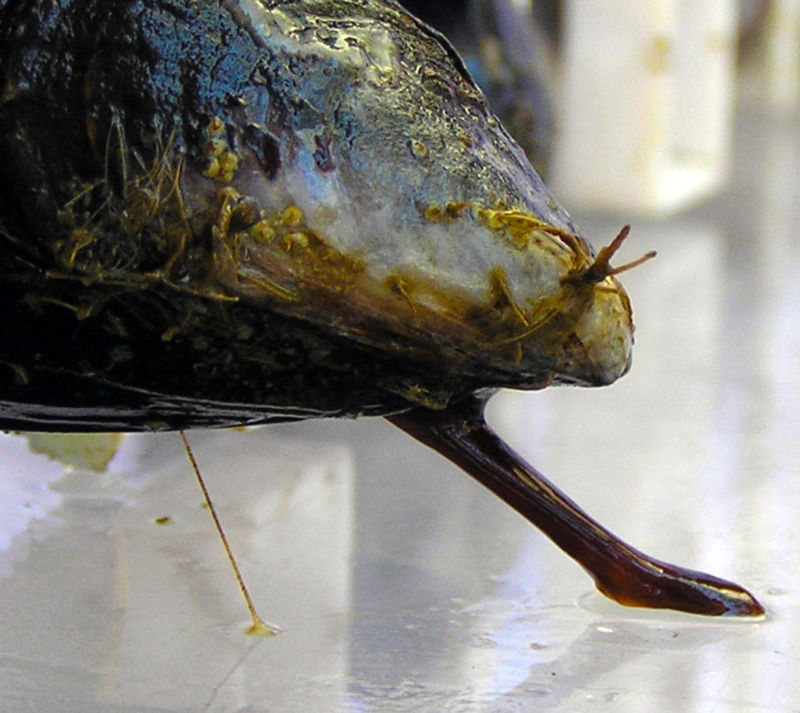
When engineers look at mussels, they're typically looking in awe at how they anchor themselves to nearly every surface imaginable, all while under water. The fibers they use to attach themselves are incredibly strong, and the adhesive works wet or dry on all sorts of materials. For the most part, engineers are looking to create a substance with similar properties.
This week, however, brings an exception: engineers who want to try to keep mussels from sticking to everything. Zebra mussels, a species that has invaded the Great Lakes, is estimated to cost utilities hundreds of millions of dollars each year due to clogged pipes and intakes. Ships, buoys, and pretty much anything else we put in the water also ends up needing to have mussels cleared off.
The international team behind the new work has designed a material that mussels can't seem to get a grip on. It's not because the mussel's adhesive fail; instead, the mussel itself doesn't seem to know what it's touching when it's set down on the material.
Oil and water
Anybody who's been near water has probably seen some form of shellfish stuck to rocks or piers, but most of us probably haven't looked closely at how they do the sticking. In the case of mussels, the animal uses an appendage (called its foot) that extends from its shell to create a web of fibers one-by-one. The result is resilient, since loss of any one fiber will still leave the shell firmly attached. And the fibers are difficult to break and tend to stay stuck on the surface, even though the adhesive the mussel uses is just a mix of simple chemicals and proteins.
Various materials have been devised that promise to limit the ability of mussels to stick. Yet each year, we spend those millions of dollars trying to clear them off of ships, pipes, piers, and other hardware.
The team behind the new work decided to try a class of materials that I didn't even realize existed: a lubricant infused material. It's less complicated than it sounds. The lubricant in this case is silicone oil, which has a backbone of silicone oxide that's linked to hydrocarbons. The material it infuses is simply a something that has an affinity for uncharged chemicals like those hydrocarbons. The silicone oil simply works its way into pores and gaps in the surface and stays there because of the chemical compatibility. Silicone oil is repelled by water (it's hydrophobic), so putting it underwater has no effect on the lubricant.
The team made two types of lubricant infused materials. One was a standard polymer (polydimethylsiloxane), the second a porous surface made from fused silica nanoparticles. While the latter can probably hold a bit more of the silica oil, the former can be made much thicker.
To test it, they simply coated some surfaces, dropped them in water, and put some mussels on. For controls, they used some untreated surfaces, as well as two commercial coatings that are supposed to repel animals. In all their tests, only a single piece of the oil-infused polymer had a mussel stick to it. It handily beat both commercial coatings (the oil-infused nanoparticles were as good as a commercial offering). In the case where mussels did stick, it took less force to pull them off, and none of the mussels' adhesive proteins were left behind afterwards.
The team next took the material out for a field test in the Atlantic Ocean. Compared to the two commercial products, the oil-infused polymer ended up with either a quarter the number of mussels on it, or one-thirtieth.
What is this stuff?
Why's it so effective? To find out, the authors dropped some mussels on the surface and filmed what happened. And it seemed the oil-infused material confused the mussels. As in normal cases, the mussel extended its foot to probe the surface it was on. But when it contacted the oil-infused material, it didn't attempt to attach any adhesive to it. Instead, the researchers saw one of three behaviors. In some cases, it simply pulled its foot back into the shell. In other cases, it gave up and attached some adhesive to its own shell. In a few cases, the mussel simply sprayed a bit of adhesive into the water.
"From the 'mussel’s perspective,'" the authors suggest, "[oil-infused] surfaces present a 400-nm-thick lubricant layer after an initial capillary adhesion, during which no solid surface would be sensed."
Of course, the mussel's perspective involves some actual biology. Here, unfortunately, the work comes across as a bunch of engineers trying out biology. They show that the mussel's foot includes some receptors encoded by a family of genes involved in sensing stress. The team suggests this is probably responsible for the mussel's ability to sense the properties of the surface it finds itself on. Depending on the species, however, these also sense heat, cold, pain, and other phenomena. So, this isn't an especially convincing conclusion.
Regardless, the work clearly makes a case that this material could cut back on the problem of having mussels grow all over everything. And it's practical to boot. The authors say it can be made into a sprayable paint.
Science, 2017. DOI: 10.1126/science.aai8977 (About DOIs).
reader comments
102